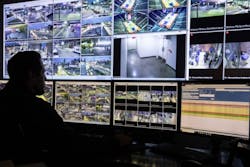RGB Spectrum working to expand its solutions base at ISC West 2023
Unless your organization or agency takes an advanced and sophisticated approach to video surveillance applications and security operation center (SOC) configurations, there is a chance that your security team has not interacted with RGB Spectrum. However, a company that is viewed as an industry leader in mission-critical video systems, RGB Spectrum has a mission of its own as it showcases its solutions at this week’s ISC West event in Las Vegas.
The company seeks to expand its exposure to non-enterprise organizations and mid-sized companies that are looking for solid integrated video solutions. As it unveils its Zio portfolio and new channel-partner program, RGB Spectrum will be spotlighting solutions that can optimize an organization’s SOC to better able decision-making where users view data sources, applications, and video feeds and if required, deliver content to any destination, over any network or to any display.
A fresh take on RGB Spectrum's Certified Partner Program will also be featured, as a new Silver and Gold partnership rolls out specific revenue and training requirements and increases benefits. The company figures these new training and support resources will soon be available and will help to ensure that a partner's organization is equipped with tools to ensure success. According to Scott Norder, the Chief Operating Officer at RGB Spectrum, there is a clear focus on deepening relationships with key partners. As it welcomes new security-focused integrators, VARs and consultants.
I was able to speak with Scott prior to this week’s ISC West show and he explained what the RGB Spectrum roadmap looks like for the near future and how it wants to grow its name value among non-enterprise-level companies. Scott and his team will be on the show floor March 29-31 at ISC West 2023 in booth #7050.
Scott Norder: First of all, we're a privately held company that was founded in 1987 by Bob Marcus, who is our CEO currently and has been throughout that entire time. He's active in the business every day and influences company direction and has a distinct interest in technology. The company has been focused on video processing and it takes many forms. The video processing is performed for high-value decision spaces, so that makes us a bit of a niche company. But those high-value decision spaces are places that you recognize very quickly. Airport control centers, security operation centers at sports stadiums and E-911 centers. Within the military, there are simulators that are using our technology for the joint strike force fighter aircraft -- VF35 and VF18. Of course, Key Helicopters uses our video processing for their training and simulation for helicopter pilots.
However, about a third of our business is in the security space, and again, they're high-profile installations. We're known for being the company that gets the source content that you have to put onto your displays in a high-quality, immediate, highly controllable and flexible fashion. We also have a segmented business, and this includes more than 10 years in video distribution via AV over IP. We use endpoints that can encode and decode using multiple different codex, which are encode and decode devices and algorithms. And those endpoints are included in the security application where sources are encoded from various locations inside and outside a facility and can be routed to desktops and large front displays, along with side displays in security operations centers so that operators can have the data that they need. It can also be re-encoded from that point and sent back out to the field via mobile applications, tablets, handhelds and computers. It's a very flexible technology allowing great decision-making based on visual feedback of what's happening in the real world.
Steve Lasky: So, the technology and the solution is higher-end, which is probably why those in the industry haven't heard of it before. Are there plans to use any of the technologies that you have to reach some of the mid-market solutions? Or is everything going to stay at the high end?
Steve Lasky: It would seem a natural fit since situational awareness solutions and real-time information-gathering software are something that you specialize in for the high-end. As we move forward, there are a lot of smaller organizations that are looking for that real-time situational awareness capability in order to be a little more proactive in security and mitigating risks. That would seem to be a good place for you to be.
Scott Norder: Oh, absolutely. And it's also supported by the general improvement in sophistication and capabilities of the IT organizations who support those rooms and those facilities. We can rely on quality networking that has the capabilities sophisticated video applications require. Ten years ago, that wasn't the case. Networks weren't always fast enough, but these days a gigabit ethernet connection to any location is an easy requirement to write, so the market is definitely expanding in that direction.
Steve Lasky: Another thing in your favor is the fact that we are seeing an expansion of the Internet of things and more endpoint devices playing on the network, along with the AV industry beginning to cross over into some security industry functionality. Talk to us about how the AV industry and the security industry are merging to create solutions that are both safety and security-oriented for customers.
Scott Norder: I can tell you, over 20 years ago, I was speaking at Infocom several times about the merger of AV, IT, and security when I first came to RGB 13 years ago. It was interesting to note that several of our independent manufacturers' reps, who we still have today, have feet in both the security and the AV side. So, we've actually looked for those people who understood the value of a good AV solution on the security side. And that's clearly been growing, and we've certainly seen all the big players recognizing that video is key to appropriate decision-making. We call it decision support and video decision support. That's really something that the expertise comes from the audio-video industry, but it has value and is readily applicable within the security applications that are predominant. As a result, it's a natural marriage. We've seen it strengthening over the course of the last decade for sure.
Steve Lasky: VMS providers at ISC are a dime a dozen and they're going to be a lot of booths for users to look at the array of VMS solutions. How do you go against the competitive set and differentiate and explain what your company can provide from a VMS perspective?
Scott Norder: I think the first thing to think about is that VMS systems and what they manage are only a portion of what is needed in a security operation center. We look at VMS systems as redundant, we look at VMSs as inputs into the video distribution that we can perform for an operation center, and you'll have computing platforms that are remote that doesn't feed into a VMS and those that can be brought in. You can be looking at live broadcast content either from your cable box or from a web widget, and you can bring that into the system. You can display it at each of the operator stations as well as on a main video wall. Then you can bring that content together with feeds from VMS.
What typically happens is an incident will occur, and an operator will recall a preset within their VMS system to show that area -- the camera's in that area. But at the same time, you can bring in information from sensor data that would be in a control application. You can bring in broadcast. There happens to be an incident and there's a news station with an overhead helicopter giving you a different perspective. You can bring all that together with an RGB AV over IP plus standard video system, and then you can redistribute it to your heart's content to all the people who need to know, including the first responders who may be part of the organization but are more likely not. Bridging that gap from inside the organization to the outside of the organization is one of the key things that we do.Steve Lasky: So, how are you going to market? Are you selling direct or are you going through the channel?
Scott Norder: We believe our products are sophisticated enough that they do require professional installation and configuration, and that means that we always go through a channel and we're very happy about the channel that we have. We spend a fair amount of time recruiting and training integrators who then learn our technologies, and can deploy them very effectively for an end user and make a very happy end user. The last thing we want to do is dump a box of parts on a customer and expect them to bring it up by themselves without any real knowledge. So, we definitely go through the integration channel.
Steve Lasky: What am I going to see new if I go to your booth during ISC West?
Scott Norder: We have a new AV over IP decoder, which is at the beginning of a new platform. That is one thing that we're most excited about. It certainly broadens our market appeal with a better pricing situation. I don't want to say cheaper, but it is definitely more cost-effective. You'll also see the extension point product, which is KVM over IP, so it's really an extension of AV over IP where you're bringing keyboard, mouse and other signals from source devices to desktops.
Our extend-point solution can handle multiple windows up to four windows on a single monitor from four different sources or from the multiple displays attached to a single computer. You'll see that technology and that content, again, can also be reflected up to live and on-demand up onto the video wall at the front of the room. It's a very transportable and shareable format for remote control, so you'll see that. And you'll see some of the newest enhancements on our video wall processing technology, the ZW 4000 series has a new version of the plus software, so you'll also see that at the show.
About the author: Steve Lasky is a 34-year veteran of the security industry and an award-winning journalist. He is the editorial director of the Endeavor Business Media Security Group, which includes magazines Security Technology Executive, Security Business and Locksmith Ledger International and the top-rated webportal SecurityInfoWatch.com. Steve can be reached at [email protected]
About the Author
Steve Lasky
Editorial Director, Editor-in-Chief/Security Technology Executive
Steve Lasky is Editorial Director of the Endeavor Business Media Security Group, which includes SecurityInfoWatch.com, as well as Security Business, Security Technology Executive, and Locksmith Ledger magazines. He is also the host of the SecurityDNA podcast series. Reach him at [email protected].




